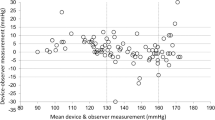Abstract
This study analyzed the accuracy/agreement of the Omron MX3 monitor on 165 adolescents. Blood pressure was measured by the automatic monitor connected in Y with the mercury column (three consecutive and simultaneous measures). The independent measures were analyzed, and the mean differences between systolic and diastolic measures for both methods were calculated and compared with British Hypertension Society (BHS) and Association for the Advancement of Medical Instrumentation (AAMI) criteria. The automatic monitor received the highest degree of BHS recommendations for systolic and diastolic blood pressures according to the BHS. The median (25th and 75th) difference between the observer and the monitor measurements was −2 (−6 and 1) mmHg for systolic and 0 (−3 and1) mmHg for diastolic pressures. The monitor also satisfies the AAMI standard for the studied population. In conclusion, the Omron MX3 Plus monitor can be considered reliable and valid for clinical practice and is in accordance with BHS and AAMI criteria.


Similar content being viewed by others
References
Alpert BC (1996) Validation of CAS model 9010 automated blood pressure monitor:children/adult and neonatal studies. Blood Press Monit 1:69–73
Altunkan S, Ilman N, Kayatürk N, Altunkan E (2007) Validation of the Omron M6 (HEM-7001-E) upper-arm blood pressure measuring device according to the international protocol in adults and obese adults. Blood Press Monit 12:219–225
Association for the Advancement of Medical Instrumentation (1993) American national standard. Electronic or automated sphygmomanometers. AAMI, Arlington, Virginia
Barker ME, Shiell AW, Law CM (2000) Evaluation of the Dinamap 8100 and Omron M1 blood pressure monitors for use in children. Paediatr Perinat Epidemiol. 14:179–186
Barquera S, Durazo-Arvizu RA, Luke A et al (2008) Hypertension in Mexico and among Mexican Americans: prevalence and treatment patterns. J Hum Hypertens 9:617–626
Coleman A, Freeman P, Steel S, Shennan A (2005) Validation of the Omron MX3 Plus oscillometric blood pressure monitoring device according to the European Society of Hypertension international protocol. Blood Press Monit 10:165–168
Cooper RS, Wolf-Maier K, Luke A et al (2005) An international comparative study of blood pressure in populations of European vs. African descent. BMC Med [electronic resource] 3
Din-Dzietham R, Liu Y, Bielo MV, Shamsa F (2007) High blood pressure trends in children and adolescents in national surveys, 1963 to 2002. Circulation 116:1488–1496
Furusawa EA, Ruiz MF, Saito MI, Koch VH (2005) Evaluation of the Omron 705-CP blood pressure measuring device for use in adolescents and young adults. Arq Bras Cardiol 84:367–370
Gordon CC, Chumlea WC, Roche AF (1988) Stature, recumbent length and weight. In: Lohman TG, Roche AF, Martorel R (eds) Anthropometric standardization reference manual. Human Kinetics Books, Champaign, pp 3–8
Ling J, Ohara Y, Orime Y et al (1995) Clinical evaluation of the oscillometric blood pressure monitor in adults and children based on the 1992 AAMI SP-10 standards. J Clin Monit 11:123–130
McGavock JM, Torrance B, McGuire KA et al (2007) The relationship between weight gain and blood pressure in children and adolescents. Am J Hypertens 20:1038–1044
Nijdam ME, Plantinga Y, Hulsen HT et al (2008) Pulse pressure amplification and risk of cardiovascular disease. Am J Hypertens 21:388–392
O’Brien E, Petrie J, Littler W (1990) The British Hypertension society protocol for the evaluation of automated and semi-automated blood pressure measuring devices with special reference to ambulatory systems. J Hypertens 8:607–619
O’Brien E, Petrie J, Littler WA et al (1993) The British Hypertension Society Protocol for the evaluation of blood pressure measuring devices. J Hypertens 11(Suppl 2):43–62
O’Brien E, Asmar R, Beilin L et al (2003) European Society of Hypertension Working Group on Blood Pressure Monitoring. European Society of Hypertension recommendations for conventional, ambulatory and home blood pressure measurement. J Hypertens 21:821–848
Perloff D, Grim C, Flack J et al (1993) Human blood pressure determination by sphygmomanometry. Circulation 88:2460–2470
Pickering TG, Hall JE, Appel LJ et al (2005) Subcommittee of Professional and Public Education of the American Heart Association Council on High Blood Pressure Research. Recommendations for blood pressure measurement in humans and experimental animals: Part 1: blood pressure measurement in humans: a statement for professionals from the Subcommittee of Professional and Public Education of the American Heart Association Council on High Blood Pressure Research. Hypertension 45:142–161
Sinha MD, Reid CJ (2007) Evaluation of blood pressure in children. Curr Opin Nephrol Hypertens 16:577–584
Stergiou GS, Tzamouranis D, Nasothimiou EG, Protogerou AD (2008) Can an electronic device with a single cuff be accurate in a wide range of arm size? Validation of the Visomat Comfort 20/40 device for home blood pressure monitoring. J Hum Hypertens 22:796–800. doi:10.1038/jhh.2008.70
Stergiou GS, Yiannes NG, Rarra VC (2006) Validation of the Omron 705 IT oscillometric device for home blood pressure measurement in children and adolescents: the Arsakion School Study. Blood Press Monit 11:229–234
Thorogood M, Connor M, Tollman S et al (2007) A cross-sectional study of vascular risk factors in a rural South African population: data from the Southern African Stroke Prevention Initiative (SASPI). BMC Public Health 13:317–326
VII JNC (2003) Report of the Joint National Committee on Prevention, Detection, Evaluation and Treatment of High Blood Pressure
Wattigney WA, Webber LS, Lawrence MD, Berenson GS (1996) Utility of an automatic instrument for blood pressure measurement in children. The Bogalusa Heart Study. Am J Hypertens 9:256–262
Wong SN, Tz Sung RY, Leung LC (2006) Validation of three oscillometric blood pressure devices against auscultatory mercury sphygmomanometer in children. Blood Press Monit 11:281–291
Zaetta V, Daniele L, Perkovic D et al (2007) Validation of the SAA-102 home blood pressure monitor according to the protocols of the European Society of Hypertension, the Association for the Advancement of Medical Instrumentation and the British Society of Hypertension. Blood Press Monit 12:363–368
Conflict of interest
The authors declare there is no conflict of interest in this paper.
Author information
Authors and Affiliations
Corresponding author
Rights and permissions
About this article
Cite this article
Christofaro, D.G.D., Casonatto, J., Polito, M.D. et al. Evaluation of the Omron MX3 Plus monitor for blood pressure measurement in adolescents. Eur J Pediatr 168, 1349–1354 (2009). https://doi.org/10.1007/s00431-009-0936-x
Received:
Accepted:
Published:
Issue Date:
DOI: https://doi.org/10.1007/s00431-009-0936-x




